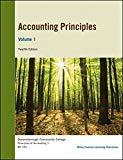
Concept explainers
(a)
Bad debts can be defined as those accounts receivable that a firm does not expect to collect and has written off to its income statement under the head, expense. They are also termed as irrecoverable debts.
Bad debts are considered as expenses, as they are not anticipated to generate any financial benefits in the future. It leads to a corresponding decrease in the balance of accounts receivable on the
Allowance method:
Allowance method can be defined as the method to write off bad debts expense. Under this method, the firm does not wait for the time when bad debts would occur. It predicts the bad debts prior to its occurrence. It can be referred to as an estimation of additional funds received from sales transactions or other source that is kept aside to be paid off for bad debt when bad debt occurs.
Direct write-off method:
Under this method, firms report the estimated uncollectible amount to Bad debts expense. Under the direct write-off method, only the actual losses are recorded as bad debt expense. The gross amount of the accounts receivable is only recorded in the financial statements.
To determine: The method of accounting for bad debts in D Company.
(b)
To prepare: The journal entries to record the transactions at December 31, 2017 for bad debt expense.
(c)
To prepare: The journal entries to record the transactions with debit balance $1,000 for allowance for doubtful accounts.
(d)
To prepare: The journal entries to record the amount of account receivable written off as uncollectible.
(e)
To prepare: The journal entries to record the amount of account receivable written off as uncollectible.
(f)
To ascertain: The type of account for Allowance for Doubtful Accounts and how accounts receivable is reported on the balance sheet at the end of the accounting period.
Want to see the full answer?
Check out a sample textbook solution
Chapter 9 Solutions
Accounting Principles 12th Edition
- What is the net income percentage?arrow_forwardNo ai answerarrow_forwardIf sales revenue is $280 million and accounts receivable decreased by $30 million, the amount of cash received from customers: a. was $280 million. b. was $310 million. c. depends on the mix of cash sales and credit sales. d. was $250 million.arrow_forward
- Not use ai solution please and accountingarrow_forwardThe following amounts have been extracted from the accounts of Sell-It at its year-end, December 31, 20x9: Sales $ 50,000 Cost of Goods Sold $ 35,000 Inventory $ 10,000 $ 8,000 Account Payable The gross profit that Sell-it would report is: a. $40,000 b. $27,000 c. $17,000 d. $60,000arrow_forwardCan you solve this financial accounting question using valid financial methods?arrow_forward

 AccountingAccountingISBN:9781337272094Author:WARREN, Carl S., Reeve, James M., Duchac, Jonathan E.Publisher:Cengage Learning,
AccountingAccountingISBN:9781337272094Author:WARREN, Carl S., Reeve, James M., Duchac, Jonathan E.Publisher:Cengage Learning, Accounting Information SystemsAccountingISBN:9781337619202Author:Hall, James A.Publisher:Cengage Learning,
Accounting Information SystemsAccountingISBN:9781337619202Author:Hall, James A.Publisher:Cengage Learning, Horngren's Cost Accounting: A Managerial Emphasis...AccountingISBN:9780134475585Author:Srikant M. Datar, Madhav V. RajanPublisher:PEARSON
Horngren's Cost Accounting: A Managerial Emphasis...AccountingISBN:9780134475585Author:Srikant M. Datar, Madhav V. RajanPublisher:PEARSON Intermediate AccountingAccountingISBN:9781259722660Author:J. David Spiceland, Mark W. Nelson, Wayne M ThomasPublisher:McGraw-Hill Education
Intermediate AccountingAccountingISBN:9781259722660Author:J. David Spiceland, Mark W. Nelson, Wayne M ThomasPublisher:McGraw-Hill Education Financial and Managerial AccountingAccountingISBN:9781259726705Author:John J Wild, Ken W. Shaw, Barbara Chiappetta Fundamental Accounting PrinciplesPublisher:McGraw-Hill Education
Financial and Managerial AccountingAccountingISBN:9781259726705Author:John J Wild, Ken W. Shaw, Barbara Chiappetta Fundamental Accounting PrinciplesPublisher:McGraw-Hill Education





